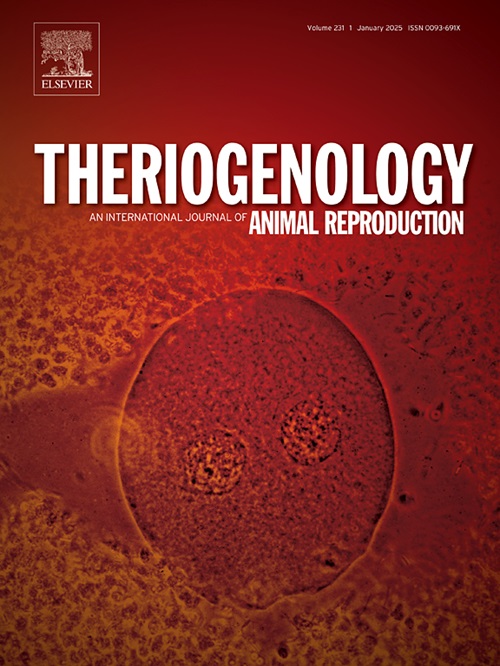JNJ-7706621激活后促进小鼠克隆过程中胚胎和足月发育
IF 2.5
2区 农林科学
Q3 REPRODUCTIVE BIOLOGY
引用次数: 0
摘要
体细胞核移植(SCNT)在动物克隆中得到了广泛的研究。然而,与通过自然繁殖产生的胚胎相比,SCNT胚胎经常表现出较低的发育潜力。本研究旨在通过评估JNJ-7706621 (JNJ,一种细胞周期蛋白依赖性激酶1和aurora激酶的特异性抑制剂)作为激活后治疗替代细胞松弛素B (cytochalasin B, CB)的作用来改善SCNT小鼠胚胎发育。用CB (5 μg/mL)或JNJ(1、10、50 μM)培养孤雌激活(PA)小鼠胚胎,确定最佳浓度。10 μM JNJ和CB组的发育能力显著高于1和50 μM JNJ组。与CB组相比,10 μM JNJ组细胞总数增加,凋亡细胞减少。经10 μM JNJ处理的SCNT小鼠胚胎发育明显改善(CB: 39.9%±6.4;JNJ: 61.4%±4.4),总细胞数增加(CB: 52.7±3.6;johnson & johnson: 70.7±2.9),内细胞团(CB: 10.4±0.7;JNJ: 15.4±1.1)和滋养外胚层细胞(CB: 42.3±3.3;Jnj: 55.3±2.5)。与CB相比,JNJ治疗显著降低了异常的f -肌动蛋白和微管蛋白。与CB相比,它还减少了单细胞胚胎的异常纺锤体,减少了双细胞SCNT胚胎的卵裂球断裂和DNA损伤。重要的是,JNJ治疗显著提高了种植率(CB: 50.8%±3.7;johnson & johnson: 68.3%±4.3)和活产率(CB: 2.4%±2.4;JNJ: 10.9%±2.8)。这些结果表明,JNJ增强了细胞骨架的完整性和染色体的稳定性,最终改善了小鼠SCNT胚胎的着床前发育和足月成功。本文章由计算机程序翻译,如有差异,请以英文原文为准。
Enhancing embryonic and full-term development during mouse cloning through post-activation treatment with JNJ-7706621
Somatic cell nuclear transfer (SCNT) is widely researched for animal cloning. However, SCNT embryos frequently exhibit reduced developmental potential compared to those generated through natural reproduction. This study aimed to improve SCNT mouse embryo development by assessing the effects of JNJ-7706621 (JNJ, a specific inhibitor of cyclin-dependent kinase 1 and aurora kinases) as a post-activation treatment, replacing cytochalasin B (CB). Parthenogenetically activated (PA) mouse embryos were cultured with CB (5 μg/mL) or JNJ (1, 10, or 50 μM) to determine the optimal concentration. The 10 μM JNJ and CB groups showed significantly higher developmental competency compared to the 1 and 50 μM JNJ groups. The 10 μM JNJ group also exhibited an increase in total cell number and a decrease in apoptotic cells compared to the CB group. SCNT mouse embryos treated with 10 μM JNJ showed improved development (CB: 39.9 % ± 6.4; JNJ: 61.4 % ± 4.4), with increases in total cell number (CB: 52.7 ± 3.6; JNJ: 70.7 ± 2.9), inner cell mass (CB: 10.4 ± 0.7; JNJ: 15.4 ± 1.1), and trophectoderm cells (CB: 42.3 ± 3.3; JNJ: 55.3 ± 2.5). JNJ treatment significantly reduced aberrant F-actin and tubulin compared to CB. It also reduced abnormal spindles in one-cell embryos and decreased blastomere fragmentation and DNA damage in two-cell SCNT embryos compared to CB. Importantly, JNJ treatment led to significantly higher implantation (CB: 50.8 % ± 3.7; JNJ: 68.3 % ± 4.3) and live birth rates (CB: 2.4 % ± 2.4; JNJ: 10.9 % ± 2.8) compared to CB. These results demonstrate that JNJ enhances cytoskeletal integrity and chromosome stability, ultimately improving both preimplantation development and full-term success in mouse SCNT embryos.
求助全文
通过发布文献求助,成功后即可免费获取论文全文。
去求助
来源期刊

Theriogenology
农林科学-生殖生物学
CiteScore
5.50
自引率
14.30%
发文量
387
审稿时长
72 days
期刊介绍:
Theriogenology provides an international forum for researchers, clinicians, and industry professionals in animal reproductive biology. This acclaimed journal publishes articles on a wide range of topics in reproductive and developmental biology, of domestic mammal, avian, and aquatic species as well as wild species which are the object of veterinary care in research or conservation programs.
 求助内容:
求助内容: 应助结果提醒方式:
应助结果提醒方式:


